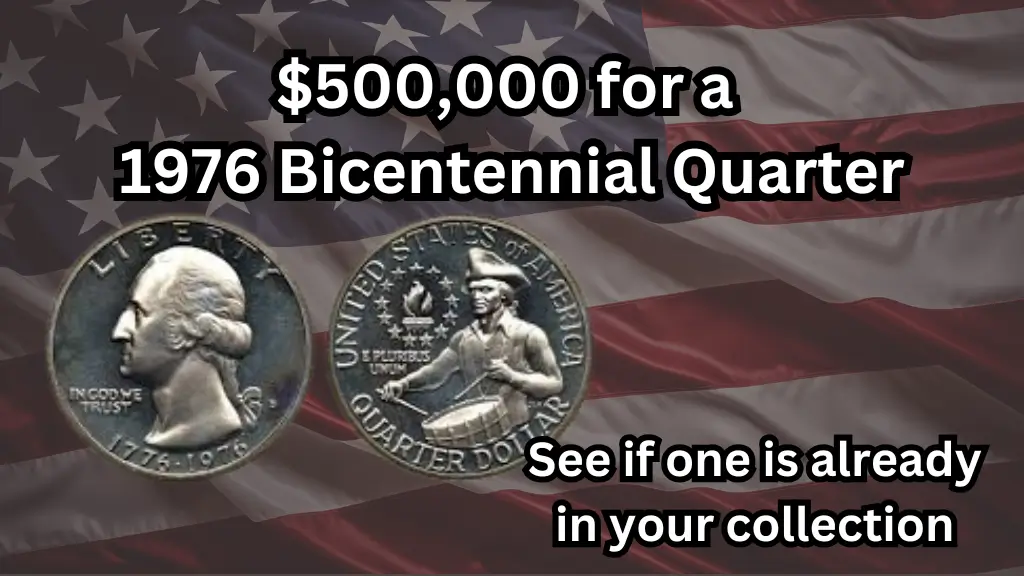$500,000 for a 1976 Bicentennial Quarter: The 1976 Bicentennial Quarter, minted to celebrate 200 years since America’s founding, may hold far more value than its face value of 25 cents suggests. While most of these coins are common, certain versions—especially those with minting errors or unique silver content—have recently been known to fetch prices that can reach into the hundreds of thousands of dollars at auction.

A Glimpse Into History
In 1976, as the United States commemorated the Bicentennial, the U.S. Mint released a special series of quarters. These coins feature an innovative design that blends American heritage with a nod to future innovation. The obverse displays an artistic take on the Liberty Bell, while the reverse retains the classic eagle design. Issued from the Philadelphia, Denver, and San Francisco Mints, each coin carries unique characteristics determined by its mint mark—Philadelphia coins have no mark, Denver coins display a “D,” and San Francisco coins bear an “S.”
The Hidden Treasure in Minting Errors
What makes some 1976 quarters so valuable are rare minting errors. These mistakes, occurring during the striking process, can dramatically boost a coin’s worth:
- Double Die Obverse (DDO): This error results in doubled images, particularly noticeable on the date or inscriptions like “LIBERTY.”
- Off-Center Strikes: When the coin’s design is misaligned, parts of it may be missing from the intended area, leading to a highly sought-after error.
- Wrong Planchet Errors: Coins struck on an incorrect metal disc instead of the standard copper-nickel clad planchet are exceptionally rare.
- Clashed Dies: On rare occasions, two dies may imprint onto the coin simultaneously, creating a ghost-like overlay of both designs.
Collectively, these minting errors have transformed what was once a simple commemorative coin into a potential goldmine for collectors, with some error coins selling for $350,000 or even more.
The Silver Connection
Another aspect that adds to the allure of the 1976 Bicentennial Quarter is its silver content. The San Francisco Mint produced a limited run of these coins in a 40% silver alloy, making them distinctly more valuable than their standard copper-nickel counterparts. To determine if your quarter might be silver, check for the “S” mint mark. Silver versions are generally heavier and non-magnetic. If in doubt, a silver testing kit or professional evaluation can provide confirmation.
How to Assess Your Coin’s Condition
The condition or grade of your quarter is paramount in determining its market value. Coins that remain uncirculated, with pristine details and no signs of wear, are highly prized. Here’s a simple guide to evaluate your coin:
- Examine the Mint Mark: Look carefully at the obverse for any mint mark. An “S” indicates a San Francisco issue—potentially with silver content.
- Inspect for Errors: Use a magnifying glass or a coin loupe to scrutinize the design. Look for doubled images, misaligned strikes, or any irregularities that might indicate a minting error.
- Evaluate the Coin’s Grade: Coins in mint condition are more valuable. Even minor scratches or dents can lower the coin’s desirability among collectors.
- Check for Silver: If your coin is from the San Francisco Mint, test its magnetic properties or weight to verify if it’s one of the 40% silver editions.
Getting a Professional Opinion
If you suspect your 1976 quarter might be a rare find, consider having it graded by professional services such as PCGS or NGC. These organizations provide certification of authenticity and condition, which can greatly enhance the coin’s resale value.
Read Also:
$1,400 Taxpayer Stimulus Checks: IRS Eligibility, Payment Timeline & How to Claim in 2025
Frequently Asked Questions
Q1: What makes a 1976 quarter valuable?
A: Valuable 1976 quarters typically have minting errors such as Double Die Obverse, off-center strikes, or wrong planchet errors. Silver content in San Francisco Mint issues also adds significant value.
Q2: How can I tell if my quarter is made of silver?
A: Check for the “S” mint mark, and test for non-magnetic properties and heavier weight. Silver testing kits can provide further confirmation.
Q3: Why are minting errors important?
A: Minting errors are rare production mistakes that make individual coins unique. Their scarcity increases collector demand and can drive prices to remarkable levels.
Q4: How do I get my coin graded?
A: You can submit your coin to professional grading services like PCGS or NGC for an official assessment of its condition and value.